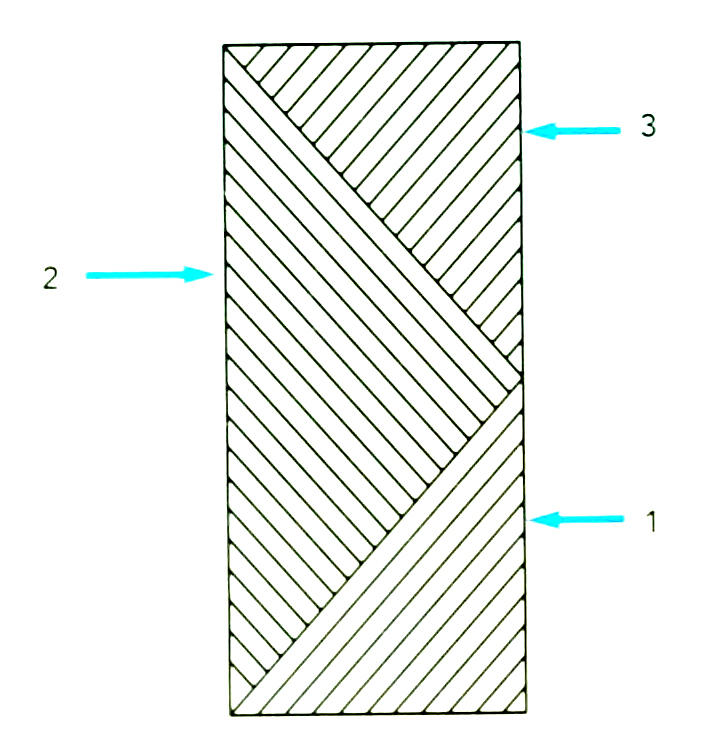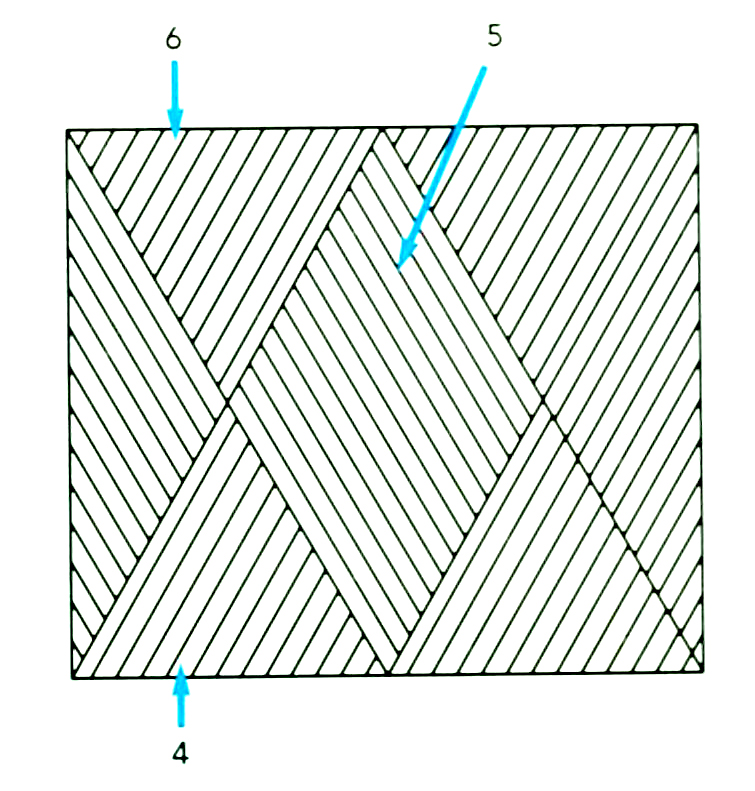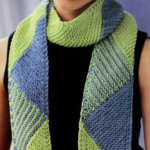Note: Practice Practice both swatches, making note of two consistent practices in this technique:
- K1 inc 1 is always used for the increase.
- Skp is always used for the decrease.
It is important to identify the location for the next increase and decrease. These are consistent for every shape. Once you can recognize where to increase and decrease, you will be able to follow the directions in the projects without needing stitch markers.
The decrease always closes the gap between the previous row’s slipped stitch and the shape to which the new shape is being joined. Skp, slipping the last stitch before the gap and knitting the first stitch after the gap.
Figure 1:
1 RIGHT TRIANGLE BEGINNING
2 SIDE EQUILATERAL TRIANGLE
3 RIGHT TRIANGLE ENDING

Figure 1:
1 UPRIGHT EQUILATERAL TRIANGLE BEGINNING
2 DIAMOND
3 UPRIGHT EQUILATERAL TRIANGLE ENDING

■ DIAGONAL TRIANGLES
In this exercise, you will practice making diagonal triangles.
Cast on 5 sts.
Step 1
Make a Right Triangle Beginning.
Row 1: K 1 inc 1 k 1 , turn; s 1 , k to end, turn-3 sts worked.
Note: There are more than 3 sts on the needles. The reference to the number of sts always indicates the number of live sts that have already been worked in the shape.
Row 3: K 1 inc 1, k5. turn; s 1, k to end, turn-7 sts.
Row 4: Kline 1, k7-9 sts.
Note: You end with twice the number of cast-on stitches minus 1.
Step 2
Make a Side Equilateral Triangle.
Start this triangle at the bottommost part of the Right Triangle Beginning.
Row 1: K1 inc 1, skp, turn; s 1 , k to end, turn-3 sts.
Row 2: K1 inc 1, kl, skp, turn; s1, k to end, turn-4 sts.
Row 3: K1 inc 1, k2, skp, tutn; s1, k to end, turn-5 sts.
Row 4: K1 inc 1 , k3, skp, turn; s1, k to end, turn-6 sts.
Row 5: K1 inc 1, k4, skp, turn; s1, k to end, turn-7 sts.
Row 6: K 1 incl , k5, skp, turn; s1, k to end, turn-8 sts.
Step 3
Make a Right Triangle Ending.
Rows 1 to 3: Repeat rows 1 to 3 of Step 2.
Row 4: S1, k3, skp, turn; s1 , k3, turn-1 st left unknitted.
Row 5: S1, pass 2nd st on right needle over 1st, k2, skp, turn; sl, k2, turn-1 st unknitted.
Row 6: S1, pass 2nd st on right needle over 1st, k 1, skp, turn; s1 , k1, turn-1 st unknitted.
Row 7: S1, pass 2nd st on right needle over 1st. skp, pass 2nd st on right needle over 1st.
Fasten off last st.
Note: Start binding off stitches (as instructed in rows 4 to 7 above) when the number of knitted stitches of the end triangle equals the number of cast-on stitches (in this exercise, 5 stitches).
UPRIGHT TRIANGLES AND DIAMONDS
Cast on 10 sts.
Step 1
Make two Upright Equilateral Triangles (5 x 5 x 5 sts each).
Row 1: K 1 inc 1, turn: sl. turn-1 st left unknitted.
Row 2: K1 inc 1, k1, turn; s1, k1, turn-2 sts left unknitted.
Row 3: K 1 inc 1, k2. turn; sl, k2, turn-3 sts left unknitted.
Row 4: Klincl, k3. turn; sl, k3, urn-4 sts left unknitted.
Row 5: K1 inc 1, k4, do not turn.
Repeat rows 1 to 5 to create a second Upright Equilateral Triangle. Turn.
Step 2
Make a Side Equilateral Triangle.
Row 1: K1 inc 1, skp, turn; s1, k2, turn-3 sts.
Row 2: K1 inc 1, k 1, skp, turn; s1, k3, turn-4 sts.
Row 3: K1 inc 1, k 2, skp, do not turn – 5 sts.
Step 3
Make a Diamond.
Row 1: K1 inc 1, k3, skp, turn; s1, k4, turn-1 st left unknitted.
Row 2: K1 inc1, k3, skp, turn; s1, k4, turn-2 sts left unknitted.
Row 3: K1 inc 1, k3, skp, turn; s 1 , k4. turn-3 sts left unknitted.
Row 4: K1 inc 1, k3, skp, turn: s 1 . k4, turn-4 sts left unknitted.
Row 5: K1 inc 1, k3, skp, do not turn.
Check your work.There should be 15 sts on the right needle and 5 sts on the left needle.
Step 4
Make a Side Equilateral Triangle facing the opposite side.
K5, turn (position at bottom of Upright Equilateral Triangle).
Repeat rows 1 and 2 of Step 2.
Row 3: K1 inc 1. k2, skp, turn; s1, k4.
Step 5
Make two Upright Equilateral Ending Triangles.
First Upright Equilateral Ending Triangle:
Row 1: K4, skp, turn; s1, k3, turn-1 st unknitted.
Row 2: S1, pass 2nd st on right needle over 1st, k2, skp, turn; s1, k2, turn-1 st unknitted.
Row 3: S1, pass 2nd st on right needle over 1st, k1, skp, turn; s1, k1, turn-1 st unknitted.
Row 4: S1, pass 2nd st on right needle over 1st, skp, bo 2 sts on right needle, skp-1 st remains on right needle.
Second Upright Equilateral Ending Triangle:
Row 1: K 1, pass 2nd st on right needle over 1st, k3, skp, turn; sl, k3, turn-1 st unknitted.
Row 2: S1, pass 2nd st on right needle over 1st, k2, skp, turn; s1, k2, turn-1 st unknitted.
Row 3: S1, pass 2nd st on right needle over 1st, k1, skp, turn; s1, k1, turn-1 st unknitted.
Row 4: S1, pass 2nd st on right needle over 1st, skp, bo 2 sts on left needle.
Fasten of last st.
NOTE: Right diagonal triangles are formed by increasing on both ends on the right side with a k1 inc 1 and on the left side by picking up an extra stitch from the base, or cast-on, row. Side equilateral triangles are formed by increasing on the side and joining with a skp to the previous triangle. As in t iic right diagonal triangles, the increase is on the right side with a klincl.The join is on the left side and connects the last stitch of the side equilateral triangle with the previous triangle’s stitch, using the skp to connect the two (making 1 stitch out of 2 stitches). Diamonds and equilateral upright triangles are formed similarly. Even though the knitting is on the diagonal, the increases take place from the top of the triangle or diamond. The join, as before, is with the skp, and connects the current shape with the previous shape.


